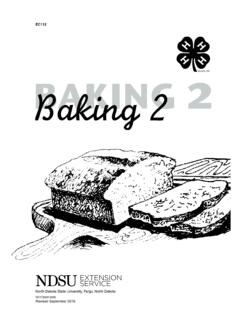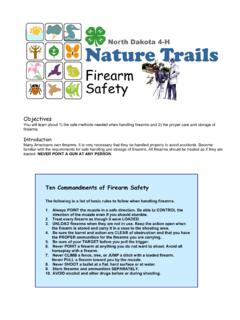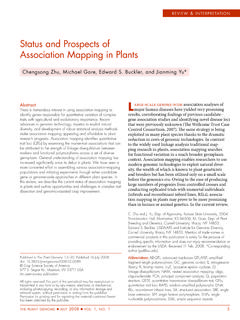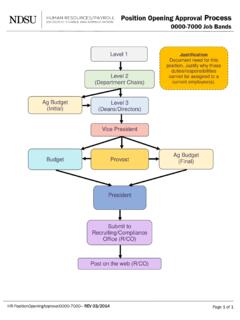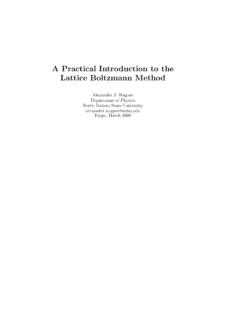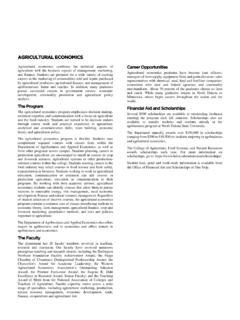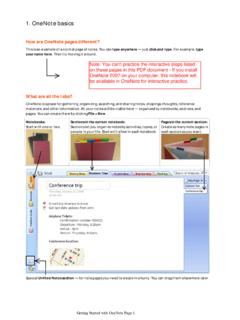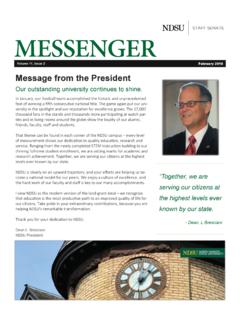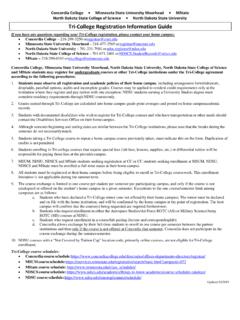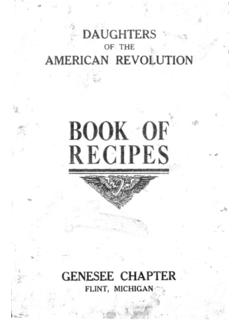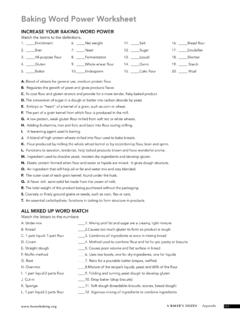Transcription of EC111 Beginning BEGINNING BAKING 1 Baking1 - NDSU
1 BEGINNING BAKING 1 BEGINNING BAKING 1 North Dakota State University, Fargo, North DakotaOCTOBER 2005 Revised September 2016 EC111 2 Message to 4-H Members ..3 Eating Well ..4 Getting Ready to Bake ..9 Basic Kitchen Equipment ..11 BAKING Terms ..12 Let s Bake Biscuits! ..13 BAKING Powder Biscuits ..13 Standards of Quality for BAKING Powder Biscuits ..14 How to Judge Baked Products: Biscuits ..15 Let s Bake Muffins! ..16 Plain Muffins ..16 Cornmeal Muffins ..17 Standards of Quality for Muffins ..18 How to Judge Baked Products: Muffins ..19 Let s Make Pancakes! ..20 Pancakes ..20 Peanut Butter Pancakes ..21 Standards of Quality for Pancakes ..21 Let s Bake Cookies! ..22 Sugar Cookies ..22 Chocolate Chip Cookies ..23 Chocolate Drop Cookies.
2 24 Oatmeal Cookies ..25 Peanut Butter Cookies ..26 Standards of Quality for Cookies ..27 How to Judge Baked Products: Cookies ..28 The Cook s Match-up ..29 Other Activities ..30 BEGINNING BAKING 1 Record Form ..31 Contents3 Message to 4-H MembersBaking I is to help first-year BAKING members learn BAKING basics nutrition, measuring and kitchen safety. The project is organized to cover one topic or food at each club will learn the basics of BAKING by making quick breads and will learn: About MyPlate and the importance of grain foods in your daily diet How to measure dry and liquid ingredients accurately Definitions of basic BAKING terms Basic kitchen and food safety practices How to make: Biscuits Muffins and muffin variations Pancakes Cookies: sugar, chocolate chip, chocolate drop, oatmeal and peanut butter How to judge the quality of each food product About jobs and careers in food preparationYou should.
3 Learn to judge the quality of each food product Attend 4-H club meetings and BAKING project meetings as available in your county Give a demonstration, teaching others BAKING basics Keep a record of your work on this project Participate in leadership and citizenship activitiesSuggested Exhibits Three biscuits Three plain muffins Three chocolate chip cookies Three sugar cookies round, plain, without icing Three chocolate drop cookies Three oatmeal cookies Three peanut butter cookiesAcknowledgmentsThe New Mexico 4-H Curriculum Review Committee revised this project in of the committee were:Shelly Porter, Colfax County Extension Home EconomistOwida Franz, Union County Extension Home EconomistBetty McCreight, Lincoln County Program Director-Home EconomistMargaret Dines, Grant County Extension Home EconomistDarlene Dickson, 4-H/Youth SpecialistLayout by:Ana Henke, Media Specialist Assistant, Agricultural Communications, New Mexico State UniversityAdapted in North Dakota by the 4-H Healthy Livestyles Programming Commitee.
4 Marcia Hellendsaas, McKenzie and Dunn County Extension Agent - Nutrition, Food Safety and Health Gail Slinde, Ward County Extension Agent - 4-H Youth Development Kaylyn Anderson, LaMoure County Extension Agent - 4-H Youth Development/Nutrition Education Macine Lukach, Cavalier County Extension Agent - Nutrition, Food Safety and Health Heather Hagen, Former Cass County 4-H Member Deb Hagen, Cass County 4-H Volunteer Leader Jane Edwards, Extension Nutrition Specialist, NDSU Department of Health, Nutrition and Exercise Sciences Julie Garden-Robinson, Extension Food and Nutrition Specialist, NDSU Department of Health, Nutrition and Exercise Sciences Carrie Stark, 4-H Youth Development Specialist, NDSU Extension Service, Center for 4-H Youth DevelopmentRevised June 2016 by Julie Garden-Robinson, Extension Food and Nutrition Specialist4 Eating WellMyPlate MyPyramid has been rebuilt and it s now a plate!
5 Here s what the colors stand for: orange - grains green - vegetables red - fruits blue - dairy foods purple - protein foodsThe Department of Agriculture (USDA) wanted an easier way to remind people to eat healthfully. MyPlate shows the five food groups using a familiar picture: a place setting with a plate, cup and fork. MyPlate SpeaksLet s look at some of the other messages this new symbol is trying to send:Balancing Calories Enjoy your food, but eat less. Avoid oversized portions. Foods to Increase Make half your plate fruits and vegetables. Make at least half your grains whole grains. Switch to fat-free or low-fat (1%) milk. Foods to Reduce Compare sodium in foods such as soup, bread and frozen meals. Choose foods with lower numbers.
6 Drink water instead of sugary drinks. 5 Make it personal. Through the USDA s MyPlate website, you can get personalized recommendations about the mix of foods you need to eat and how much you should be eating. How Much Do I Need to Eat?Everyone wants to know how much he or she should eat to stay healthy. That s a tricky question, though. It depends on your age, whether you re a girl or boy, and how active you are. Kids who are more active burn more calories, so they need more calories. GrainsGrains are measured in ounce equivalents. What are they? Ounce equivalents are just another way of showing a serving size. Here are ounce equivalents for common grain foods. An ounce equivalent equals:1 piece of bread cup of cooked cereal, such as oatmeal cup of rice or pasta 1 cup of cold cereal 4- to 8-year-olds need 4 to 5 ounce equivalents each day.
7 9- to 13-year-old girls need 5 ounce equivalents each day. 9- to 13-year-old boys need 6 ounce equivalents each one last thing about grains: Make at least half your grain food choices whole grains, such as 100 percent wheat bread, brown rice and oatmeal. VegetablesOf course, you need your vegetables, especially those dark green and orange ones. But how much is enough? Vegetable servings are measured in cups. 4- to 8-year-olds need 1 cups of veggies each d ay. 9- to 13-year-old girls need 2 cups of veggies each day. 9- to 13-year-old boys need 2 cups of veggies each , juicy fruit definitely is part of a healthy diet. Here s how much you need: 4- to 8-year-olds need 1 cup to 1 cups of fruit each day. 9- to 13-year-old girls need 1 cups of fruit each day.
8 9- to 13-year-old boys need 1 cups of fruit each d foods are rich in calcium to build strong bones to last a lifetime. 4- to 8-year-olds need 1 to 2 cups of milk (or other calcium-rich food) each day. 9- to 13-year-old girls need 3 cups of milk (or other calcium-rich foods) each day. 9- to 13-year-old boys need 3 cups of milk (or other calcium-rich foods) each you want something other than milk, you can substitute yogurt, cheese or calcium-fortified orange juice just to name a FoodsThese foods contain iron and lots of other important nutrients. Like grains, these foods are measured in ounce equivalents. An ounce equivalent of this group would be:1 ounce of meat, poultry or fish cup cooked dry beans 1 egg 1 tablespoon of peanut butter a small handful of nuts or seeds 4- to 8-year-olds need 3 to 4 ounce equivalents each day.
9 9- to 13-year-old girls need 5 ounce equivalents each day. 9- to 13-year-old boys need 5 ounce equivalents each ! That s a lot to swallow. The good news is that your mom, dad and the other grownups in your life will help you eat what you need to stay healthy. Here s more good news: You don t have to become a perfect eater overnight. Adapted with permission from FREE enjoy your food, but eat less10 tips to enjoying your meal You can enjoy your meals while making small adjustments to the amounts of food on your plate. Healthy meals start with more fruits, vegetables, grains, protein foods, and dairy. Drink and eat less sodium, saturated fat, and added sugars. 10 tipsNutrition Education SeriesGo to for more information. DG TipSheet No.
10 18 Revised January 20161 get to know the foods you eat Use the SuperTracker to find out what kinds of foods and how much to eat and to get tips and support for making better food choices. 2 take your time Be mindful to eat slowly, enjoy the taste and textures, and pay attention to how you feel. Use hunger and fullness cues to recognize when to eat and when you ve had use a smaller plate Use a smaller plate at meals to help with portion control. That way you can finish your entire plate and feel satisfied without if you eat out, choose healthier options Check and compare nutrition information about the foods you are eating. Preparing food at home makes it easier to control what is in your satisfy your sweet tooth in a healthy way Indulge in a naturally sweet dessert dish fruit!
